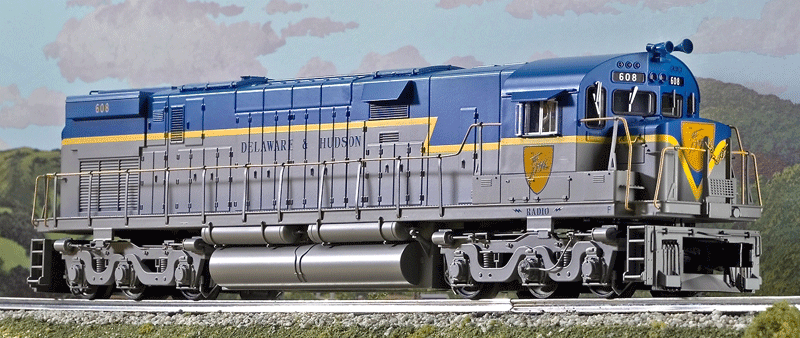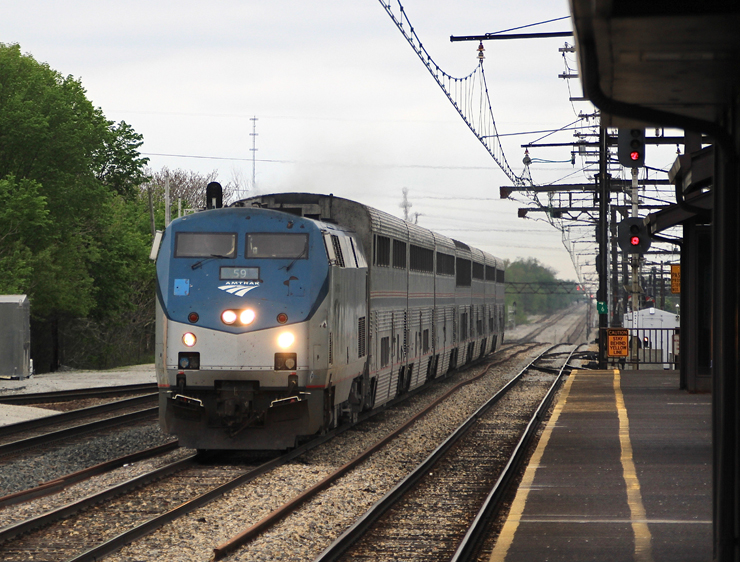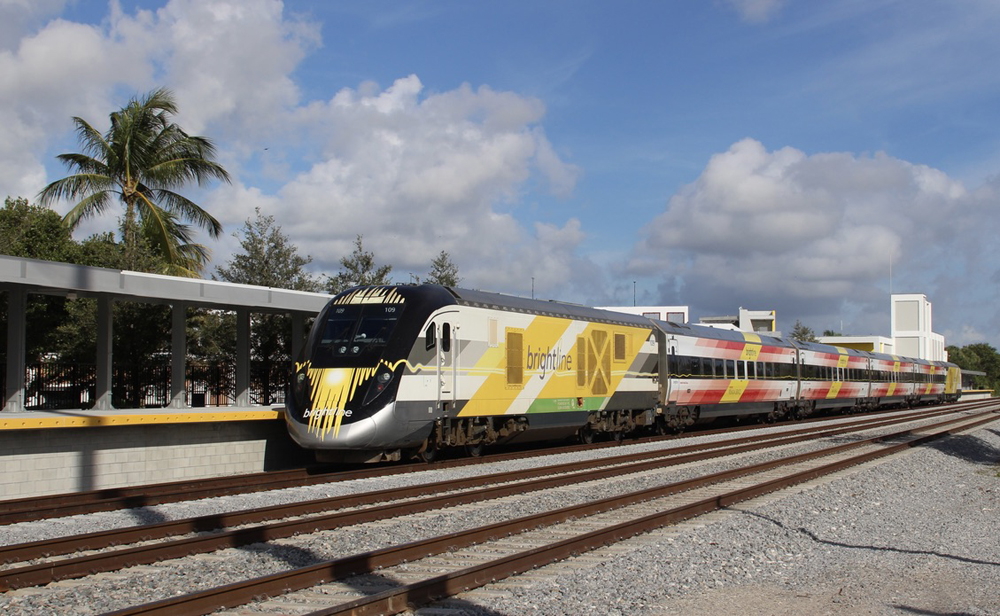Of course, Alco didn’t secure anything, but the 180 C-628s the factory cranked out were still mighty impressive. The locomotive featured a supercharged 251C 16-cylinder prime mover that generated 2,750 horsepower. Now we have an impressive O gauge model of this diesel from Atlas O.
The model
The Atlas O C-628 is an attractive scale-sized model of Alco’s big, six-axle diesel. The frame of this new model measures 64 feet in O scale (16 inches in length). That’s pretty darn close to the prototype locomotive’s frame, which was 64 feet 8 inches long.
The pilot features a brake line and eight multiple-unit cables, along with a simulated uncoupler arm and, just below the coil coupler, a slight wedge of a snowplow.
The steps on the pilot have drain holes and look great. On the platform you’ll find safety tread decking and handrails painted yellow with gray stanchions. A safety chain protects O scale figures from accidents at the drop-down drawbridge used in for multiple-unit operation. As an example of the level of detail, the bridge also has drain holes.
The manual brake hand pump is located in a recess next to the cab door. This is a nice design difference compared to its location on EMD and other Alco products.
As with the early Atlas O C-424, there are fine wire grab irons on the corners of the nose. The grab irons even have simulated rivet heads where they are affixed to the nose. The engineer’s side of the nose has two grab irons to aid crew members cleaning the windshields or adding sand through the sander cap. The four forward- and two rear-facing cab windows have simulated wiper arms. All the doors are cast-in.
The cab features crew figures, non-opening cab windows, sun screens over the side windows, and a horn mounted on top. Headlights are above the center of the cab, with number boards and markers nearby. You can select which style of lights (white or green) you wish to run by flipping a switch on the inside of the shell, behind the backup battery.
The body detail is excellent. The seams, hatches, latches, and doors are all deeply cut and look realistic. The roof has maintenance access hatches with “latches” that have tiny bolt heads where they’re attached to the body.
The rear of the hood matches the nose for detail and then raises the ante with grab irons that lead up to the roof. You’ll also see two golden-white headlights separating the number boards.
Looking below the water line, so to speak, the die-cast metal trucks are outstanding. They mirror the Alco tri-mount trucks to a “T.” They have separate springs, brake hardware, and even delicate sanding lines.
You can’t miss the huge die-cast metal fuel tank (the prototype C-628 held 2,000 gallons of fuel, 2,000 gallons of cooling water, 250 gallons of lubricating oil, and 48 cubic feet of sand). You’ll also find a long spout for fuel jutting out on the fireman’s side of the tank.
Interestingly, Atlas O used a new method of packaging for this model that includes a rigid plastic base. The model is held to the base with screws, the same way many small die-cast metal cars and trucks are held in place in their boxes to avoid shipping damage.
The screws feed up through the bottom of the base and into the fuel tank. Atlas O provides you with four tiny rubber plugs to fill the holes in the tank once the locomotive is unpacked.
The only aspect of this locomotive that missed the mark was the lack of any “see-through” screen details. There are just a handful of opportunities on a C-628 for see-through screens or louvers, and all were cast into the plastic shell.
While Lionel’s SD40T-2, which also is reviewed in this issue, isn’t as technologically advanced as the Atlas O C-628, it does have a fair quantity of “see-through” screens and vents.
The paint application on our Atlas O model is flawless. This model is also available undecorated and in Atlantic Coast Line, Lehigh Valley, Lousiville & Nashville, and Southern Pacific colors.
On the test track
The Atlas O C-628 was a pleasure to operate. Motor operation of the C-628 was very responsive and very quiet.
Thanks to Engineer-On-Board speed control, our low-speed test average was 2.7 scale mph, and the high-speed average was 87.2 scale mph. Drawbar pull was 2 pounds 10 ounces. The Alco’s six-axle (12-wheel) drive system is among the top pullers that we have tested.
The locomotive has four pickup rollers, two on each truck roughly 2 inches apart, and 6 inches between trucks. Traction tires are mounted on the inboard wheel sets of each truck.
The run/program, sound, speed-control and smoke-unit switches are located on the frame beneath the cab. A volume control is on the belly of the fuel tank.
On our sample, the battery connector wire hookup was oddly fed and its wires were split around the motor. We experienced some wire wear from the spinning motor flywheel. After we relocated the wire, all went well.
The aforementioned marker-light selection switch is located on the inside of the end of the shell. You’ll need a fine screwdriver or other pointed tool to flick the switch.
The sound system was good, and the smoke unit produced a very satisfactory haze of the white stuff.
All in all, the C-628 is a darned credible model of the prototype. It looks big and bad and boasts great pulling power. Running it was a pleasure. The designers of the Alco prototype would be pleased.
Price: $479.95 (no. 1332 Delaware & Hudson); $229.95 (nos. 138-1/2 Delaware & Hudson unpowered)
Features: O-54 operation, two can-style motors, TrainMaster Command Control, RailSounds, speed control, smoke unit
Pros: Sharp body details, robust motor system; deep, throaty sound
Cons: None
Made in the People’s Republic of China for Atlas O















yep!Looks like that locomotive can became my first locomotive!!!!!